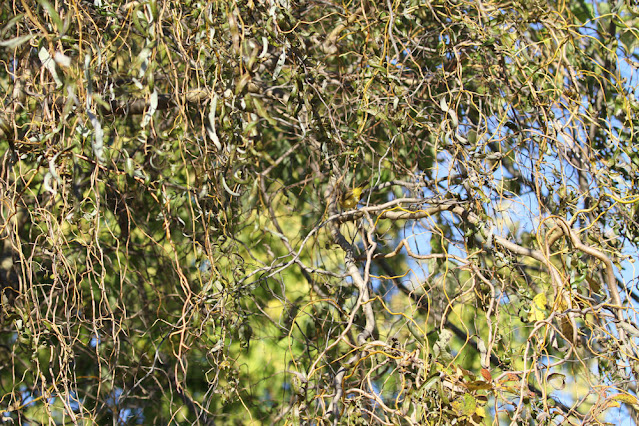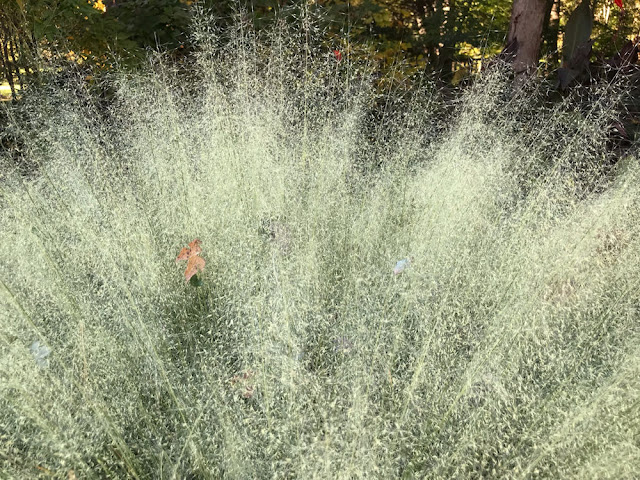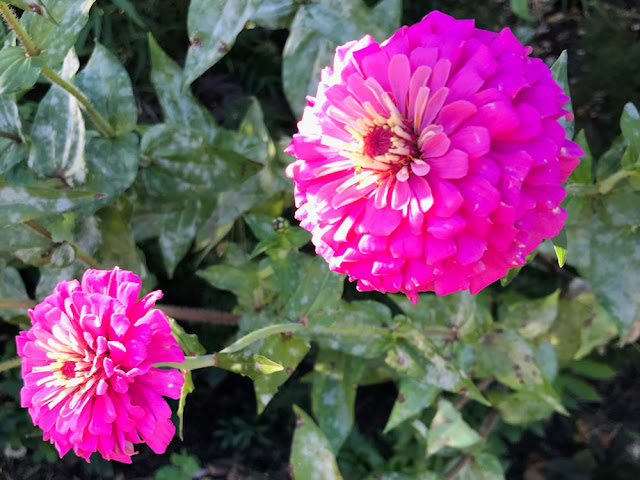There are several Adirondack chairs throughout the garden, in addition to the benches. I like the look of them very much. They were originally called the Westport Chair and there is an interesting history of its origins at this link.
Gregg takes a lot of photos that I share and there are several in these garden posts. He spotted the bird in the tree, which turned out to be an Eastern Bluebird. Bluebirds are found throughout North America including the Eastern, Western and Mountain Bluebirds.  Nesting occurs from March through August. Only the female incubates the 4-6 eggs which she maintains at a temperature of 98 to 100ºF. All bluebirds are cavity nesters and will use an artificial nest box. Habitat and nest cavities had been disappearing for many years, but bluebirds have made an incredible come back due to thousands of bluebird nest boxes being installed across the country.
Nesting occurs from March through August. Only the female incubates the 4-6 eggs which she maintains at a temperature of 98 to 100ºF. All bluebirds are cavity nesters and will use an artificial nest box. Habitat and nest cavities had been disappearing for many years, but bluebirds have made an incredible come back due to thousands of bluebird nest boxes being installed across the country.
 Nesting occurs from March through August. Only the female incubates the 4-6 eggs which she maintains at a temperature of 98 to 100ºF. All bluebirds are cavity nesters and will use an artificial nest box. Habitat and nest cavities had been disappearing for many years, but bluebirds have made an incredible come back due to thousands of bluebird nest boxes being installed across the country.
Nesting occurs from March through August. Only the female incubates the 4-6 eggs which she maintains at a temperature of 98 to 100ºF. All bluebirds are cavity nesters and will use an artificial nest box. Habitat and nest cavities had been disappearing for many years, but bluebirds have made an incredible come back due to thousands of bluebird nest boxes being installed across the country.The next one my Dear Other Half found is the American Goldfinch. Very hard for me to see and I am always glad for his sharp eyesight. It was resting among all those tangled branches. The American Goldfinch is a common sight at backyard feeders. The small birds are found across most of North America, though they do avoid thick forests. The American Goldfinch is also the state bird of Iowa, New Jersey, and Washington.
The American Goldfinch is the only finch species that molt twice a year. The first time is in the spring when the males get their bright yellow feathers, and the second is at the end of summer when the darker feathers grow in. A female Goldfinch typically lays between 2 to 7 eggs. The eggs are either greenish-blue or light blue. It takes twelve days for the eggs to hatch, and another 12 days before the hatchlings fledge.
The following shows the Milkweed plant with its pod split exposing the seeds. You can read about it at this link.
The seeds are equipped with hairy filaments which facilitate dispersal by wind.
During windy days, seeds often travel 25 to 100 feet away from the mother plant.
When Milkweed splits open they reveal 50-100 seeds, each with a white, fluffy coma ("parachute") that allows wind dispersal, as mentioned above.
Common milkweed is Nature's mega food market for insects. Over 450 insects are known to feed on some portion of the plant, and must not forget the plant's importance to the Monarch Butterfly. The ones I found on this one are called Milkweed Bugs (Oncopeltus fasciatus). If you click on this link it will take you to a page with more information.
An Oxeye daisy, botanical name Leucanthemum vulgare. Also known as Ox-eye daisy, Dog daisy, Moon daisy, White daisy and Marguerite.
Oxeye daisy is a small perennial and our largest native member of the daisy family. It is a widespread flowering plant native to Europe and the temperate regions of Asia, and an introduced plant to North America, Australia and New Zealand.
These are called the Aromatic aster, botanical name Symphyotrichum oblongifolium. Its other names are Fall aster, Oblong-leaf aster and Oblong-leaved aster. The Armomatic aster is native to parts of eastern and central United States.
The plant below is called the Hair-awn muhly, botanical name Muhlenbergia capillaris. Also known as Hairy-awn muhly, Muhly grass, Hair grass, Pink muhly and Gulf muhly. It is a perennial, sedge-like plant. It likes a lot of sunlight. It attracts beneficial insect species and is also considered an excellent wildlife habitat plant that provides great cover.
The grass was named after Heinrich Ludwig Muehlenberg (1753-1815), German educated Lutheran minister and first president of what is now Franklin and Marshall College, Lancaster, Pennsylvania.
He was America's first outstanding botanist who published Index Flora Lancastriensis in 1785.
This pretty orange flower is the Sulfur cosmos botanical name Cosmos sulphureus. Other names are Klondike cosmos, Yellow cosmos and Orange cosmos. It is native to Mexico, Central America and northern South America, and naturalized in other parts of North and South America, as well as Europe, Asia and Australia. The flowers of all Cosmos attract birds and butterflies, including the Monarch butterfly. You can read more at this link.
This is the dried leaf from thee Pin Oak, botanical name Swamp Spanish oak or Swamp oak. My plant app told me "Your plant is dried out, suggesting it is dormant or dead." It doesn't realize I see the beauty in dried leaves that I find on the ground, but I'm happy it identifies even these. It is a deciduous tree native to North America. The Pin Oak has favorable growing qualities and is one of the most common oak species used in landscaping.I saw several Common zinnias blooming but these were the only ones that were not totally past it. The others were a little straggly. Botanical name Zinnia elegans. Also known as Zinnia, Elegant zinnia, Youth-and-age and Wild zinnia. The name was given to the plant in memory of another German botanist Johann Gotfried Zinn. It also symbolizes friendship in the language of flowers. You can learn more about it if you click on this link.
Next is a Purple coneflower and I certainly wasn't expecting any at this time of the year, but then this is where I get my education walking around these gardens. Botanical name Echinacea purpurea. Also known as Eastern purple coneflower and Hedgehog coneflower. It is native to the eastern United States, and purple coneflower is found in many flower gardens.
There is a very nice website called "Fun in Fairfax Virginia". This link is about the garden. There is quite a lot of advertising but the photos are wonderful and will give you more insight into Meadowlark.
And last of all my dear little flying pig. Did you know that The Flying Pig has origins in Greek mythology, legend and folklore? The original flying pig was a winged boar named Chrysaor, the offspring of the Gorgon Medusa and the Greek sea god Poseidon. The winged horse Pegasis was his brother. And as for its meaning of following a story someone might tell you that you can't quite believe, followed by you perhaps saying, "and pigs might fly." I read, "Flying pigs appeared in print in the UK quite often throughout the rest of the 19th century. The Illustrated Times referred to them in an issue in August 1855: "...pigs might fly. An elephant, too, might dance on the tight-rope." Always amazes me what I can find online.
We started in the fairy garden and we are ending there as this little pig is keeping company with the remaining fairies. I have known it for years. The next time we meet, hopefully, will be when we come back for their Winter Walk of Lights.
In the meantime it hopes you have enjoyed your walk around the garden. Thank you for joining us and have a great weekend.























The fancy grass, I have never seen any like it. I cannot think of anything to compare it to, it is so divine and unique!! The Bluebird and goldfinch shots are so sweet. And the color on this Cosmos, wow! The milkweed bugs are both beautiful and creepy at the same time.
ReplyDeleteThanks Ginny, I have never noticed this grass on previous visits, unless it was just at its peak as I walked by. I have been along that path many times before over the years. I suppose it could be newly planted earlier on in the year, or even maybe last. I loved it, it was so pretty and 'fluffy'. This Cosmos is a beautiful color and being someone who is fascinated with milkweed bugs and its ilk, I think them pretty too but in a different way, and I certainly wouldn't want them crawling over me ;)
DeleteI knew about monarchs & milkweed, but not those bugs. Such an enchanting garden. So diverse, and interesting. And learning the myth if a flying pig was something new!!!
ReplyDeleteHi Anni and thank you! Enchanting is a great description for this garden. And as for the flying pig, that was new to me too, though the little sculpture I have taken photos of before :)
DeleteBelas fotografias deste excelente jardim.
ReplyDeleteUm abraço e bom fim-de-semana.
Andarilhar
Dedais de Francisco e Idalisa
O prazer dos livros
Muito obrigado! Estou feliz que você tenha gostado deste jardim. Um abraço e feliz final de semana :)
DeleteSo many wonderful things to see there. That grass is so interesting. I've never seen anything like it.
ReplyDeleteI say the same thing Ann, every time I go, many wonderful things :) The grass is really something isn't it? Thank you!
DeleteHello,
ReplyDeleteLove the photos, nice sightings of the Bluebird and Goldfinch. The flowers are beautiful, my favorite is the Oxeye daisy! Happy Friday, enjoy your weekend!
Hello Eileen, glad you enjoyed the birds. I was so happy Gregg spotted them. The Oxeye daisies are lovely! Thank you and Happy Friday and enjoy your weekend also.
DeleteI got at least one college credit for reading your post. Interesting information.
ReplyDeleteWell, as family, friends and others have always said to me, "You have a very curious mind", and I admit myself that I am a detailed kind of a person. Or as my Dad used to say, "You miss nothing.", lol! Honored at your compliment Red, thank you :)
DeleteYou had such great weather on this outing, Denise, and I have enjiyed all the posts and the provided background information. i agree with a previous comment that the grass was quite unusual and made for great photo opps.
ReplyDeleteWe certainly did Dorothy and thank you :) It was gorgeous! Happy you enjoyed our walks from the garden. It provides many photo ops and a peacefulness that I love.
DeleteI just love that orange Cosmos flower! Imagine a field covered with them. Gorgeous!
ReplyDeleteYes, wouldn't it be wonderful? Thank you Gigi :)
Delete
ReplyDeleteI really like birds, but sometimes I have no patience to photograph them :) This pig is unusual, I did not know this story about flying pigs. Have a nice weekend:)
Thank you Lucyna, and yes taking photos of birds requires patience. We were lucky this time, and we were walking by when the birds were seen in the tree :)
DeleteLovely walk.
ReplyDeleteHappy you enjoyed Christine and thank you :)
Deletethe little bluebird is beautiful - lots of pretty photos in this post - love it!
ReplyDeleteThank you Carol, the bluebird is a dear little bird isn't it? :)
DeleteI love your curiosity that takes us along with you on your lovely walks through this beautiful spot! You and your husband are wonderful photographers. The grasses you featured are quite special and some I have never seen. The flying pigs are darling and give such a magical ending to your visit. Thank you!
ReplyDeleteThank you Martha Ellen and you are very welcome. I will pass that on to Gregg also :) So glad you enjoyed the things we saw on our walk.
DeleteSeeing the bluebird made me think of the song about bluebirds flying over the rainbow and the goldfinch reminded me of a children's book about Little Grey Rabbit who made a fan from collected feathers that had been shed by a goldfinch and had floated to the ground. You saw some lovely flowers and the information was as usual very interesting.
ReplyDeleteThank you Linda, I shall have to look up those books you mentioned :) Happy you found this interesting.
DeleteBeautiful shots. We call those Muskoka chairs.
ReplyDeleteThank you William and how interesting :)
Deletehi denise...you always provide so much information in your posts and i really enjoy it. most i don't know. my favorite here is the hair-awn mthly, i don't think i have ever enjoyed it before...it is so light and fluffy!! i adore cosmos...around here, they are all purple and i am just fine with that!!
ReplyDeletefun info about the birds, the bluebird is stunning!! there are bluebirds everywhere in new jersey but they don't visit yards, they are more of a forest bird. i do see a lot of goldfinches at my feeders, the males are gorgeous!!
Hi Debbie, so glad you enjoy all the information I find. The muhly was extraordinary to see I thought. I would love to see your purple cosmos. Yes I know how much you would enjoy those :))) I wish I could see more bluebirds and now I know where they hang out :) Strangely enough we got a lot of goldfinches at our feeders last week. I was really surprised as I have never seen them as late this year.
DeleteI certainly enjoyed my walk with you, fabulous photographs, and that grass is amazing.
ReplyDeleteAwww I did like the little flying pig :)
Enjoy your weekend.
All the best Jan
So glad Jan :) Glad you liked the little flying pig :) You enjoy your weekend also and all the best to you :)
Delete😍
ReplyDeleteThank you R's Rue :)
DeleteNice pictures from your walk!
ReplyDeleteThank you Ashok :)
DeleteI love the pig! Beautiful critters. Our bluebirds are gone!
ReplyDeleteThank you Jenn! They certainly are. I guess your bluebirds are visiting us now :)
DeleteYou know your stuff when it comes to birds and plants (and a bunch of other topics as well.) Helping out with the Leave No Trace people when they were in town last week, I worked with a naturalist who knew all about butterflies and what they eat and what kind of plants they like and all that. There was a forester there working for the state and he showed me a bunch of stuff as well.
ReplyDeleteThank you Yogi, learning as I go along, and I am trying to remember by writing everything down :) That all sounds very interesting, something I would have enjoyed attending most definitely.
DeleteGreat variety of photos, Denise. One of the restaurants in our little town named themselves Goldfinch. Sweet bluebird, too.
ReplyDeleteThank you Ellen and I bet the restaurant has a sweet logo :)
DeleteLove that pig :)
ReplyDeleteWonderful new things for me to see.
Thank you.
Thanks Margaret and you are very welcome :)
DeleteWell, that is amazing about flying pigs! Interesting post.
ReplyDeleteThank you Linda, I am happy you found it interesting.
DeleteYour photographs are amazing, especially the bird photos. Thanks so much for sharing.
ReplyDeleteThank you Buttercup and you are very welcome. We have my husband Gregg to thank for those photos. I will let him know how much you liked them :)
DeleteBeautiful Autumn gardens and I love the bluebird!
ReplyDeleteI loved that little bluebird too Sallie :) Can you believe it was 75 degrees today? The turtles will be so confused!
Delete